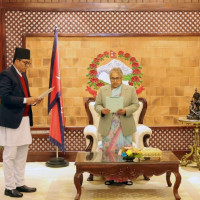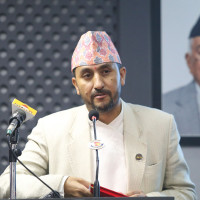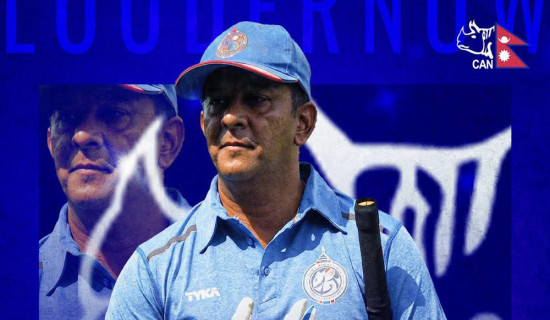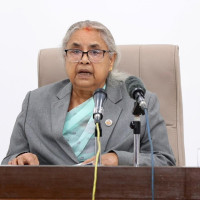- Tuesday, 16 December 2025
Melamchi project plans to build new intake: Shrestha
Experts have consistently raised concerns about the sustainability of water supply from the current source under the Melamchi Water Supply Project. In response, the Melamchi Water Supply Development Board has announced plans to construct a permanent intake and desander approximately 300 to 400 metres upstream from the existing spring.
Kamalraj Shrestha, executive director of the Melamchi Water Supply Development Board, has highlighted the risk of potential landslides in the area. He explained that a significant landslide occurred on July 17, 2020, and there is a possibility of it happening again at any time. Due to this concern, he emphasized that immediate reconstruction of infrastructure or structures in the affected area is not advisable.
Shrestha stated, "Experts believe that we cannot continue drawing water from the current water source due to the recurring threats of landslide. A major landslide occurred immediately after we started drawing water, and there is a high chance of it recurring and reaching that area again." He mentioned that a formal decision was being made to address this issue and added, "Preparations are underway to construct an additional tunnel of 400 to 500 metres, along with a permanent intake and a sand pumping system located 300 to 400 metres upstream from the existing spring."
Shrestha further explained that the lack of a system to manage the influx of muddy water and the uncertainty surrounding heavy rain and its impact on different parts of Melamchi have led to the closure of water supply for now. He emphasized the need to avoid unnecessary risks and assured that the situation would be reassessed before resuming the water supply.
Excerpts from the conversation The Rising Nepal's Indira Aryal/Sapana Thami had with Kamal Raj Shrestha, Director General, Melamchi Water Supply Development Board, recently regarding the Melamchi Water Project.
How is Melamchi water distributed during the rainy season?
The headwork structure, which was devastated by a flood two years ago, was completely destroyed, making it impossible for Melamchi to provide a continuous water flow. Currently, the water supply is closed during the rainy season and resumes after the season. This has been the situation since the last fiscal year.
Due to the sudden dissolution of the Melamchi Development Board, recovery from the damage to the Melamchi water supply project has been challenging. We were unable to complete the necessary work. At present, we have managed the water diversion mechanism to handle muddy water and major floods. However, due to the unpredictability of flooding, especially when there is heavy rain in the upper part of Melamchi and muddy water is present, we have closed the water supply temporarily. The Department of Meteorology has forecast below-average rainfall, so we are monitoring the situation closely.
We visited Melamchi headwork last Saturday to assess the situation, and we will be visiting the spring again next week. If the water level is low and clean, we may be able to release water during the middle of the season. Additionally, local springs in Kathmandu will have increased flow during the rainy season, allowing households to access water easily through wells and hand pumps. However, there is a risk of water scarcity in the winter months. We have closed the supply temporarily due to muddy water, but we will resume supplying water when it becomes clear and clean.
What is the condition of the Melamchi headwork?
We need to evaluate the headwork carefully. According to experts, a flood of such magnitude occurs once every 10,000 years. Instead of immediately building a permanent structure, we must observe the behaviour of the river for one or two years. Compared to the previous year, the river's water level has dropped by six metres. We will continue to monitor the river's behaviour during this rainy season as well. Based on the observations, experts believe that a devastating flood of the same magnitude is unlikely to occur immediately. Therefore, rather than rushing into construction this year, we need to be prepared for the recovery work. It is not feasible to continue drawing water from the current source due to the high risk of landslides. Thus, we are planning to relocate the intake. The decision to shift the headwork to another location has been made, and preparations are underway to construct an additional tunnel of 400 to 500 metres, along with a permanent intake and desander system, located upstream from the current spring. This monsoon, we have progressed with our preparations by closing the tunnel during muddy water conditions and opening it when the water is clear. At present, we are unable to supply water for 365 days.
When was the contract signed with Sino Hydro Corporation?
Sino Hydro signed the contract in September 2019. They had almost completed their work before CMC, the Italian contractor, left. Exactly two years ago, the structure they built was washed away in a major flood. We will not be reconstructing that structure as we plan to relocate the intake. We are extending the deadline to accommodate the necessary work. The contract will be closed until August and October, by which time a new intake will be implemented through a mid-term solution, allowing us to provide water for twelve months using a different structure. The design estimation and tendering process for this project are currently underway.
What is the hope after Prime Minister Pushpa Kamal Dahal Prachanda's on-site visit to Melamchi?
There is much hope. Previously, access to the headwork was blocked for 12 months, and it still is. Since we cannot reach the spring, we are unable to provide water for twelve months. Now that the Prime Minister has visited the Melamchi headwork site, it is crucial for the relevant department to proceed with the construction of an access road. If access to the estuary becomes easier, our intervention will be timely. In that case, water can be supplied regularly.
How much has the project cost so far? What was the physical damage caused by the flood two years ago?
The Melamchi Development Board spent 30.5 billion in the last fiscal year. This includes land acquisition (covering 1900 ropanis), social upliftment programmes, various studies, environmental assessments, and detailed designs. Our responsibility was to bring water to Sundarijal. The project implementation directorate has already spent the same amount to deliver water from Sundarijal to every household in Kathmandu.
The flood that occurred two years ago submerged the estuary area, causing significant damage to estuary dams, intake structures, and headwork structures, costing billions. We are utilizing the remaining funds for the project. The cost of relocating the intake cannot be determined until a detailed estimate is prepared, but it may range from Rs. 2 to 3 billion. This includes the construction of the desander and headwork, as well as clearing the debris. The final cost will depend on the design and estimation process.
Has the project's delay led to an increase in costs?
The cost increase cannot be determined until we have a detailed estimate for the new work. We need to assess the level of risk and optimize the project accordingly. Constructing a structure on a river does not provide a 100 per cent guarantee. We have calculated and designed the structure to withstand the current situation. However, without a detailed design, it is impossible to determine the exact cost, considering potential future floods and submersion.
We are currently designing a medium-term solution for this fiscal year to continue water supply from the current location for two months until the intake is relocated. But to what extent this solution will work needs to be determined. Most of the work has been completed, and we need to connect the desander system. If that happens, we won't have to spend much more. We are focused on minimizing costs while ensuring the relocation of the headwork. Currently, we estimate an expenditure of around 20 million rupees, as this is not a long-term solution. To provide water for 12 months until the intake is relocated, additional work needs to be done on the existing headwork structure, which can be done at a relatively low cost. The cost may range from 80 million to 500 million rupees.
We need to prepare a new work estimate and evaluate the required investment. Our primary focus now is on providing water at the lowest possible cost and relocating the spring.
What are the local complaints?
There haven't been many complaints from the locals. The flood was not caused by the Melamchi project; it was a result of natural calamities, climate change, and flooding. We are bringing water to Kathmandu from the estuary area of Melamchi and Helambu Rural Municipality. However, the locals had complaints before the disaster occurred. They believe that they should benefit from the water that the people in the valley are consuming. They are requesting for a certain amount of revenue from the distribution of water. We are working to address their demands by considering a percentage of the revenue generated from the commercial distribution of water.
In conclusion, providing drinking water service to the federal capital is a project of paramount importance and national pride. With support from all government agencies, from the central level to local government, the hope that was lost due to the flood two years ago can be restored. We are moving forward with the belief that such devastating floods will not occur again. If there is no muddy water during this monsoon, we can resume water supply regularly from mid-August onwards. We can currently supply water for 10 months or 300 days. With positive support for the project, we can provide pure, natural water from the ice-melt.

















